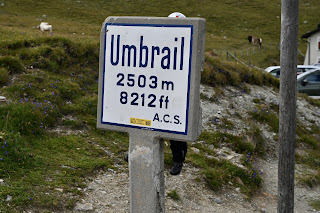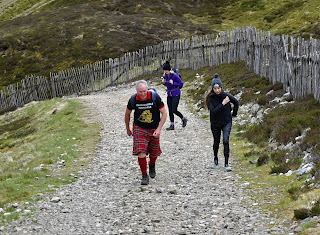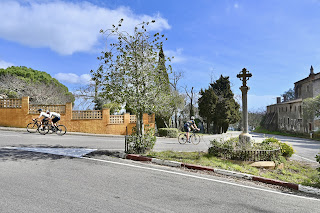The Munros are Scottish hills over 3000 feet (914.4 m) and when I did them in 2005 there were 284 of them. However, two were downgraded since then and so there are 282 left. On Saturday, the 27.05.2023 Mike Hamment compleated his round of the Munro and this blog entry is about Mike's compleation.
So what are the Munros? In the late 19th century, Sir Hugh Thomas Munro from Kirriemuir near Dundee visited higher Scottish hills and measured their height. He then published a list of hills over 3000 feet in the 6th issue of the Scottish Mountaineering Club journal in 1891. Munro climbed all but two of them. Hugh Munro's list soon became known as "the Munros" and "bagging the Munros" is today the most popular challenge for Scottish mountaineers. Reverend Archibald Eneas Robertson was likely the first to climb all of the Munro's in 1901 although some question, based on his notes, whether he had actually climbed Ben Wyvis. Today, the Scottish Mountaineering Club maintains an online list with all the "compleators" (the "ea" is not a typo!) which is here https://www.smc.org.uk/hills/compleators. To date 7422 mountaineers have compleated.
So how did Mike from Oxford start his round of the Munros? Mike was a close friend of the late Roger Ramsbottom who was my best friend in the UK. After I moved to the UK in 1997, I met Roger during an exercise physiology conference and Roger and I soon started hillwalking in the Lake District, in the Alps and we had one winter trip to Scotland where we failed to ascend neither Ben Nevis nor Sgurr nan Gillean on Skye, due to a gale and verglas, respectively. However, I realised that Scotland had stunning scenery and that the Scottish Munro's were a real challenge even for someone who has done several 4000ers in the Alps. In 2002, I started as a lecturer at the University in Dundee and one evening with Roger and Mike before that I bet that I would do the Munros in three years. For three years the Munros became my obsession and I compleated in 2005 as Munroist number 3346.
Roger got married to Waew but Mike had caught the bug and in 2007 he declared that he was now a Munro bagger. For him this was a much bigger challenge than for me because he lives in Oxford and had to travel to Scotland for each Munro trip. Roger and I joined him frequently and there are stories, stories, stories, and even more stories.
Fast forward to 2023. In February, Roger had died because of melanoma which was a great shock to us. Roger was our Munro brother and we despite his cancer diagnosis we hoped that he would be there with us when Mike would do his last Munro. It was not to be. And then Mike set the 27.05.2023 as a date and declared that the Cairnwell, the easiest of all the Munros, should be his last Munro. This is where the story of this blog entry starts.
On Thursday the 25.05., I first flew to Frankfurt and then on to Glasgow where I arrived very late. Because of the queue at the taxi stand, I decided to walk a bit more than a mile to my hotel in Renfrew and went to bed long after midnight. In the morning of Friday the 26.05., Isabelle, a french Munro bagger who had done Blaven on Skye with Mike and Roger picked me up and we drove to Glen Lyon to meet Amanda and Mike at the dam to climb Stuchd an Lochain (960 m), Mike's second to last Munro. It was great to see Mike and to walk the Munro in perfect Munro weather with great views to e.g., Buachaille Etive Mor. It was as if I had never left.
Here are Isabelle, Amanda and Mike setting off at the dam...
... and here we are already some metres up the hill with the lochain below.
After the steep part of the ascent the angle flattens and you can just see the corrie with a loch plus the summit of Stuchd an Lochain.
Also, in the distance are the hills of Glen Coe. We could see Buachaille Etive Mor.
We finally reached the summit cairn of Mike's second to last Munro. Here we are!
Here, Mike points towards Ben Challum, the last Munro that Roger Ramsbottom climbed in 2019.
On the way down we saw a ptarmigan...
... and had good views towards Glen Lyon.
Here is Mike knowing that there is only one Munro left!
In the afternoon we drove to Ballater near Balmoral not far from Aberdeen. Here is the main street.

Ballater is probably the most royalist place in Scotland because the locals benefit from all the Balmoral visitors. Here is evidence for that...

... and here is the beautiful Dee valley from the local hill. 
We then drove to Ballater youth hostel, had a rip off price but average food menu in the Clachan grill (avoid unless they come to their senses) and after wine and some Arran whisky we went to bed and the Saturday arrived.
We drove to the Glenshee ski resort where Mike's family, his Munro companions and James the piper were meeting at 11.30 h to start at 12 h. I also met my winter climbing partner Simon and his wife Christine who joined Mike's big day. And roughly at noon our group of 40 walkers, from children to seniors, women and men, started to ascend the Cairnwell (930 m), Mike's last Munro.
Here is Mike in front of Ballater hostel dressed for his last Munro...
... and here James the piper and all others set off. Mike walked with the people towards the back so that everyone would have a chance to see him compleating his round of the Munros!
Here is Mike higher up...
... and here is James the piper, piping half way up and near the summit with 360 degree views to the other Glenshee hills, Lochnagar and the central Cairngorms.
Finally the big moment arrived. We all formed a guard of honour and Mike walked in the middle and ascended the cairn whilst everyone cheered him on and whilst James was piping.
Who has just compleated the Munros? It is Mike Hamment, Munroist number 7000 and something!
After champagne, tablets and cookies we all descended, returned to Ballater and met at the golf club dressed with at least a wee bit of tartan. James piped again, we had a photo on the golf course...
... Mike got an award...
... and after wee talks by myself and Simon, Mike presented photos of his round of the Munros mentioning everyone who joined. I am sure the Hamment family has a new hero now and understands why Mike was obsessed with compleating his round of the Munros. All of us also thought of Roger Ramsbottom who seemed to be Mike's twin brother.
Finally on the Sunday, Mike had organised a trip to Balmoral castle. What a great idea as I had never visited it despite living in Aberdeen which is down the road. Here is the castle...

... and when we arrived there was an oldtimer meet with many Rolls Royce parked outside.

Here is another one in front of the tower.

... and here is the spirit of ecstasy, the figure on the bonnet of a Rolls.

On Sunday I went to Glasgow and had to visit the Duke of Wellington now with a traffic cone on the Duke and on its horse. The Duke-traffic cone combo is now a sign for Glasgow.

Finally a visit to George Square, a bus to my hotel in Renfrew, a very early start and 6 am flight first to Frankfurt and then home to Munich.

Congratulations again Mike, compleating the round of the Munros is a bloody hard thing to achieve! It was a fantastic time and I am looking forward to seeing you again soon.
HW

.jpeg)




.jpeg)





























































